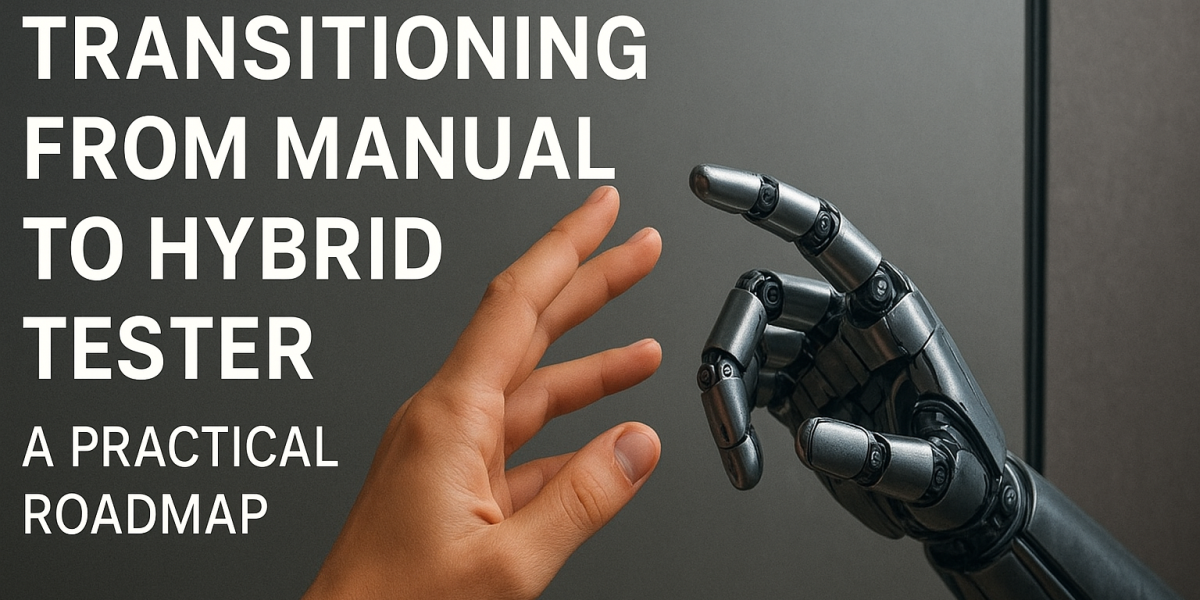Transitioning from Manual to Hybrid Tester : A Practical Roadmap

In today’s fast-paced software development world, the line between manual testing and automation testing is no longer rigid. Organizations increasingly expect testers to contribute not only through exploratory and functional testing but also by leveraging automation to accelerate delivery and improve quality. This shift has given rise to the Hybrid Tester—a professional who balances the strengths of manual testing with the efficiency of automation.
As a manual tester preparing to expand your skillset, this roadmap will serve as a practical guide for your transformation.
Why Transition to a Hybrid Tester Role?
- Increased Demand: Employers value testers who can perform manual validation while also writing automated checks.
- Career Growth: Expanding into automation broadens your test automation career path, making you more adaptable.
- Efficiency: Automation helps with repetitive checks, while manual testing ensures coverage for complex scenarios.
- Future Readiness: Agile and DevOps environments thrive on continuous testing, where hybrid testers fit perfectly.
At PIT Solutions, we empower testers to evolve into hybrid roles, blending manual expertise with automation skills. Our software testing & QA services focus on building versatile professionals ready for modern delivery pipelines.
Strengthening Manual Testing Foundation
Before diving into automation, ensure your manual testing fundamentals are solid.
- Master test case design techniques (boundary values, equivalence partitioning, exploratory testing).
- Understand SDLC and STLC thoroughly.
- Develop skills in requirement analysis, test planning, and defect reporting.
- Stay curious about user behaviour and business needs.
Remember, even the most advanced automation relies on a tester’s ability to think critically and design meaningful test cases. Strong software testing skills remain the foundation of every great hybrid tester.
Learn Programming for Automation
Transitioning from manual to automation testing requires a programming foundation. While becoming a developer isn’t necessary, having a solid grasp of the following will be essential:
- Core concepts: variables, loops, conditions, functions, OOP basics.
- Languages: Start with Python, Java, or JavaScript—widely used in test automation.
- Practice: Use coding platforms like HackerRank, LeetCode, or Exercism to build confidence.
Selecting the Right Automation Tool
Once comfortable with coding basics, move into automation tools:
- UI Testing: Selenium, Playwright, Cypress.
- API Testing: Postman, REST Assured.
- Mobile Testing: Appium.
- Frameworks: TestNG, JUnit, PyTest, Mocha.
Tip: Start small—automate simple test cases, then gradually progress to building full regression suites.
Integration Automation into CI/CD Pipelines
Hybrid testers don’t stop at writing scripts—they integrate them into the delivery pipeline. Learn how to:
- Use CI/CD tools like Jenkins, GitHub Actions, or GitLab CI.
- Manage source control with Git.
- Work with containerization tools like Docker.
This ensures your automated tests run smoothly in development and production-like environments—an important aspect of modern software testing services.
Balance Automation with Manual Testing
Automation is powerful, but it’s not a replacement for manual testing. As a hybrid tester, one should:
- Use automation for regression, smoke, and repetitive tests.
- Use manual testing for exploratory, usability, and edge case testing.
- Adopt risk-based thinking to decide what to automate and what not to automate.
Developing Essential Soft Skills
Transitioning to a hybrid role also requires soft skills:
- Collaboration: Work closely with developers, product owners, and DevOps engineers.
- Analytical thinking: Identify gaps in requirements and testing.
- Adaptability: Stay open to new tools, methodologies, and technologies.
- Communication: Report test results clearly to both technical and non-technical stakeholders.
These complement technical growth and strengthen your quality assurance (QA) career path.
Building a Continuous Learning Habit
Testing is evolving rapidly with AI, machine learning, and cloud-based platforms. Continuous learning is key:
- Follow QA communities, blogs, and podcasts.
- Contribute to open-source automation projects.
- Take certifications (e.g., ISTQB Agile, Certified SDET, Postman API testing).
Conclusion
The shift from manual to hybrid tester may seem tough, but it’s a rewarding journey that strengthens any QA career. By blending strong testing fundamentals with programming, automation, and DevOps, a tester evolves into a versatile professional.
Remember—automation boosts speed, but human intuition and creativity remain unmatched. The hybrid tester role delivers the best of both worlds: efficiency and insight. With guidance, the right mindset, and support from experienced software testing & QA services, your transition from manual to automation testing will open up a future-ready test automation career path.










